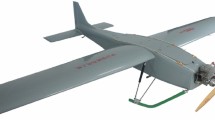Abstract
This paper shows the performance of various traction control strategies that aim to minimize slippage and wheel fighting by properly adjusting the velocity of each traction wheel in a planetary rover. These strategies are validated through simulations performed in ANVEL (Quantum Signal LLC) and using two rovers currently employed by NASA. These experiments use similar features to those that a planetary rover would face on the Moon such as terrain geomorphology and lunar gravity. After running those experiments, the following conclusions were drawn: (1) when no traction control is considered, results show the rover gets entrapped or makes a shorter progress than when traction control is applied; (2) the proposed traction controllers demonstrate a proper balance between slip-compensation (lowest mean slip) and reduction of wheel fighting effects (less aggressive control actions); (3) after considering two different planetary rovers, it is observed that the mechanical configuration effects slip reduction. These contributions can also be observed in the accompanying videos.











Similar content being viewed by others
References
Andrews, D., Colaprete, A., Quinn, J., Bluethmann, B., & Trimble, J. (2015). Resource prospector (RP)—Early prototyping and development. In AIAA SPACE conference and exposition. Pasadena, CA, USA: AIAA.
Arvidson, R., DeGrosse, P., Grotzinger, J., Heverly, M., Shechet, J., Moreland, S., et al. (2017). Relating geologic units and mobility system kinematics contributing to Curiosity wheel damage at Gale Crater, Mars. Journal of Terramechanics, 73, 73–93.
Baumgartner, E., Aghazarian, H., Trebi-Ollennu, A., Huntsberger, T., & Garrett, M. (2000). State estimation and vehicle localization for the FIDO Rover. In G. McKee, & P. Schenker (Eds.), Proceedings of SPIE, sensor fusion and decentralized control in robotic systems III (Vol. 4196).
Gonzalez, R., Apostolopoulos, D., & Iagnemma, K. (2018). Slippage and immobilization detection for planetary exploration rovers via machine learning and proprioceptive sensing. Journal of Field Robotics, 35(2), 231–247.
Gonzalez, R., & Iagnemma, K. (2018). Slippage estimation and compensation for planetary exploration rovers. State of the art and future challenge. Journal of Field Robotics, 35(4), 564–577.
Gonzalez, R., Rodriguez, F., & Guzman, J. L. (2014). Autonomous tracked robots in planar off-road conditions. Modelling, localization and motion control. Berlin: Springer.
Grotzinger, J. P., Crisp, J., Vasavada, A. R., Anderson, R. C., Barry, R., & Blake, D. F. (2012). Mars Science Laboratory Mission and Science Investigation. Space Science Reviews, 170(1), 5–56.
Heiken, G., Vaniman, D., & French, B. (Eds.). (1991). Lunar sourcebook. Cambridge: Cambridge University Press.
Helmick, D., Roumeliotis, S., Cheng, Y., Clouse, D., Bajracharya, M., & Matthies, L. (2006). Slip-compensated path following for planetary exploration rovers. Advanced Robotics, 20(11), 1257–1280.
Iagnemma, K., & Dubowsky, S. (2004). Mobile robots in rough terrain. Estimation, motion planning, and control with application to planetary rovers. Berlin: Springer.
Iagnemma, K., & Ward, C. C. (2009). Classification-based wheel slip detection and detector fusion for mobile robots on outdoor terrain. Autonomous Robots, 26(1), 33–46.
Kim, S. (1969). The evaluation of a cone penetrometer as an index of farm vehicle mobility (Unpublished doctoral dissertation). Montreal, QC: McGill University.
Krebs, A., Thueer, T., Carrasco, E., & Siegwart, R. (2008). Towards torque control of the CRAB rover, Los Angeles, USA.
Lamon, P., & Siegwart, R. (2007). 3D position tracking in challenging terrain. The International Journal of Robotics Research, 26(2), 167–186.
Parnell, B. (2015). Slippery slope sends Curiosity rover on a new route across Mars. Forbes Tech.
Peynot, T., & Lacroix, S. (2003). Enhanced locomotion control for a planetary rover. In IEEE international conference on intelligent robots and systems (IROS) (Vol. 1, pp. 311 – 316). IEEE.
Rohani, B., & Baladi, G. (1981). Correlation of mobility cone index with fundamental engineering properties of soil (Techical Report). US Army Waterways Experiment Station.
Rosenbluth, W. (2001). Investigation and interpretation of black box data in automobiles: A guide to the concepts and formats of computer data in vehicle safety and control systems (Tech. Rep.). ASTM/SAE.
Ulsoy, A., Peng, H., & Cakmakci, M. (2012). Automotive control systems. Cambridge: Cambridge University Press.
Wong, J., & Reece, A. (1967). Prediction of rigid wheel performance based on the analysis of soil-wheel stresses. Part I. Performance of driven rigid wheels. Journal of Terramechanics, 4(1), 81–98.
Acknowledgements
The research described in this publication was carried out at the Massachusetts Institute of Technology (Cambridge, MA) and ProtoInnovations (Pittsburgh, PA), under the STTR Contract NNX15CA25C funded by NASA.
Author information
Authors and Affiliations
Corresponding author
Additional information
Publisher's Note
Springer Nature remains neutral with regard to jurisdictional claims in published maps and institutional affiliations.
Rights and permissions
About this article
Cite this article
Gonzalez, R., Apostolopoulos, D. & Iagnemma, K. Improving rover mobility through traction control: simulating rovers on the Moon. Auton Robot 43, 1977–1988 (2019). https://doi.org/10.1007/s10514-019-09846-3
Received:
Accepted:
Published:
Issue Date:
DOI: https://doi.org/10.1007/s10514-019-09846-3




